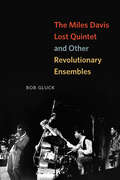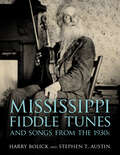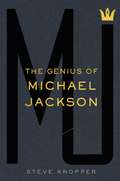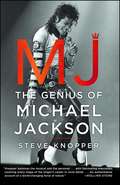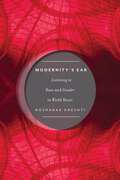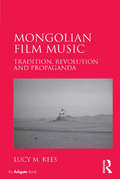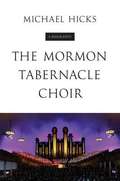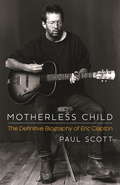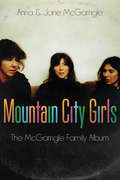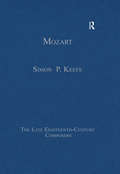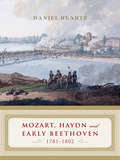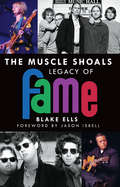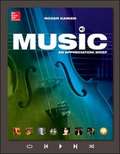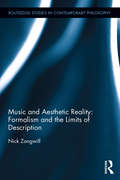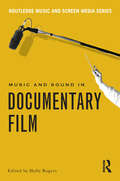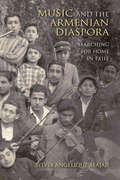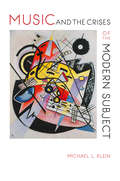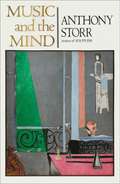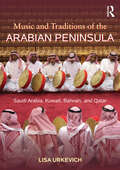- Table View
- List View
The Miles Davis Lost Quintet and Other Revolutionary Ensembles
by Bob GluckMiles Davis’s Bitches Brew is one of the most iconic albums in American music, the preeminent landmark and fertile seedbed of jazz-fusion. Fans have been fortunate in the past few years to gain access to Davis’s live recordings from this time, when he was working with an ensemble that has come to be known as the Lost Quintet. In this book, jazz historian and musician Bob Gluck explores the performances of this revolutionary group—Davis’s first electric band—to illuminate the thinking of one of our rarest geniuses and, by extension, the extraordinary transition in American music that he and his fellow players ushered in. Gluck listens deeply to the uneasy tension between this group’s driving rhythmic groove and the sonic and structural openness, surprise, and experimentation they were always pushing toward. There he hears—and outlines—a fascinating web of musical interconnection that brings Davis’s funk-inflected sensibilities into conversation with the avant-garde worlds that players like Ornette Coleman and John Coltrane were developing. Going on to analyze the little-known experimental groups Circle and the Revolutionary Ensemble, Gluck traces deep resonances across a commercial gap between the celebrity Miles Davis and his less famous but profoundly innovative peers. The result is a deeply attuned look at a pivotal moment when once-disparate worlds of American music came together in explosively creative combinations.
Mississippi Fiddle Tunes and Songs from the 1930s (American Made Music Series)
by Harry Bolick Stephen T. AustinWhile in the Mississippi State Archives tracking down Abbott Ferriss's beautiful photographic portraits of musicians from 1939, author Harry Bolick discovered, to his amazement, a treasure trove of earlier fiddle tunes in manuscript form. Since then he has worked to understand how this collection came to exist and be set aside. With Stephen T. Austin, Bolick has transcribed the subsequent 1939 audio recordings. Mississippi Fiddle Tunes and Songs from the 1930s presents the history of the collecting work, with over three hundred of the tunes and songs and a beautiful selection of period photographs. In the summer of 1936, over one hundred fiddle tunes, many of them unique, along with thousands of songs, were collected and notated throughout a large part of Mississippi. Roughly 130 novice field workers captured beautiful tunes and tantalizing fragments. As a body of work, it is an unparalleled and fascinating snapshot of vernacular music as heard in Mississippi in the early part of the recorded era. However, this music was unpublished and forgotten. In 1939, building on the contacts made three years earlier, Herbert Halpert led one of the last and best executed of the WPA folklore projects which recorded audio performances in Mississippi. Some, but not all, of those distinctive fiddle tune recordings have been published. Additionally, through cassette tape copies passed hand to hand, some of these distinctive tunes have regained currency and popularity among contemporary fiddlers. In Mississippi Fiddle Tunes and Songs from the 1930s, this great music is at last widely available. Selected tunes in this book are available from Document Records. Get Harry Bolick's CD with 22 tunes from the book, more information, a video, and free downloads of the sound files at www.mississippifiddle.com.
MJ: The Genius of Michael Jackson
by Steve KnopperThe ultimate critical biography of the King of Pop: a panoramic, vivid, and incisive portrait of Michael Jackson that explores and celebrates his influence in music, dance, and popular culture, drawing on 400 interviews. From the moment in 1965 when he first stepped on stage with his brothers at a local talent show in Gary, Indiana, Michael Jackson was destined to become the undisputed King of Pop. In a career spanning four decades, Jackson became a global icon, selling over 400 million albums, earning thirteen Grammy awards, and spinning dance moves that captivated the world. Songs like "Billie Jean" and "Black and White" altered our national discussion of race and equality, and Jackson's signature aesthetic, from the single white glove to the moonwalk, defined a generation. Despite years of scandal and controversy, Jackson's ultimate legacy will always be his music. Rolling Stone contributing editor Steve Knopper delves deeply into Michael Jackson's music and talent. From the artist's early days with the Jackson 5, to his stratospheric success as a solo artist, to "Beat It" and "Thriller," "Bad" and "The Man in the Mirror," to his volatile final years, his attempted comeback, and untimely death, Knopper explores the beguiling and often contradictory forces that fueled Michael Jackson's genius. Drawing on an amazing 400 interviews--ranging from Jackson's relatives, friends, and key record executives to celebrities like will.i.am and Weird Al Yankovic--this critical biography puts all the elements of his career into perspective, and celebrates his triumph in art and music. This is a rare and panoramic view into the genius and influence of an incomparable talent.
MJ: The Genius Of Michael Jackson
by Steve KnopperThe ultimate critical biography of the King of Pop: a panoramic, vivid, and incisive portrait of Michael Jackson that explores and celebrates his influence in music, dance, and popular culture, drawing on 400 interviews.From the moment in 1965 when he first stepped on stage with his brothers at a local talent show in Gary, Indiana, Michael Jackson was destined to become the undisputed King of Pop. In a career spanning four decades, Jackson became a global icon, selling over 400 million albums, earning thirteen Grammy awards, and spinning dance moves that captivated the world. Songs like "Billie Jean" and "Black and White" altered our national discussion of race and equality, and Jackson's signature aesthetic, from the single white glove to the moonwalk, defined a generation. Despite years of scandal and controversy, Jackson's ultimate legacy will always be his music. Rolling Stone contributing editor Steve Knopper delves deeply into Michael Jackson's music and talent. From the artist's early days with the Jackson 5, to his stratospheric success as a solo artist, to "Beat It" and "Thriller," "Bad" and "The Man in the Mirror," to his volatile final years, his attempted comeback, and untimely death, Knopper explores the beguiling and often contradictory forces that fueled Michael Jackson's genius. Drawing on an amazing 400 interviews--ranging from Jackson's relatives, friends, and key record executives to celebrities like will.i.am and Weird Al Yankovic--this critical biography puts all the elements of his career into perspective, and celebrates his triumph in art and music. This is a rare and panoramic view into the genius and influence of an incomparable talent.
Modernity's Ear: Listening to Race and Gender in World Music (Postmillennial Pop #3)
by Roshanak KheshtiFearing the rapid disappearance of indigenous cultures, twentieth-century American ethnographers turned to the phonograph to salvage native languages and musical practices. Prominent among these early "songcatchers" were white women of comfortable class standing, similar to the female consumers targeted by the music industry as the gramophone became increasingly present in bourgeois homes. Through these simultaneous movements, listening became constructed as a feminized practice, one that craved exotic sounds and mythologized the 'other' that made them. In Modernity's Ear, Roshanak Kheshti examines the ways in which racialized and gendered sounds became fetishized and, in turn, capitalized on by an emergent American world music industry through the promotion of an economy of desire. Taking a mixed-methods approach that draws on anthropology and sound studies, Kheshti locates sound as both representative and constitutive of culture and power. Through analyses of film, photography, recordings, and radio, as well as ethnographic fieldwork at a San Francisco-based world music company, Kheshti politicizes the feminine in the contemporary world music industry. Deploying critical theory to read the fantasy of the feminized listener and feminized organ of the ear, Modernity's Ear ultimately explores the importance of pleasure in constituting the listening self.
Mongolian Film Music: Tradition, Revolution and Propaganda
by Lucy M. ReesIn 1936 the Mongolian socialist government decreed the establishment of a film industry with the principal aim of disseminating propaganda to the largely nomadic population. The government sent promising young rural Mongolian musicians to Soviet conservatoires to be trained formally as composers. On their return they utilised their traditional Mongolian musical backgrounds and the musical skills learned during their studies to compose scores to the 167 propaganda films produced by the state film studio between 1938 and 1990. Lucy M. Rees provides an overview of the rich mosaic of music genres that appeared in these film soundtracks, including symphonic music influenced by Western art music, modified forms of Mongolian traditional music, and a new genre known as ’professional music’ that combined both symphonic and Mongolian traditional characteristics. Case studies of key composers and film scores are presented, demonstrating the influence of cultural policy on film music and showing how film scores complemented the ideological message of the films. There are discussions of films that celebrate the 1921 Revolution that led to Mongolia becoming a socialist nation, those that foreshadowed the 1990 Democratic Revolution that drew the socialist era to a close, and the diverse range of films and scores produced after 1990 in the aftermath of the socialist regime.
Monster High: Welcome to Boo York
by Perdita FinnIt's fright lights, big city when the Monster High ghouls head to Boo York. Cleo de Nile is invited to attend a fancy gala celebrating the return of a magical comet and, of course, she brings along her beast friends. But their trip isn't all fun and frightseeing because Nefera, Cleo's sister, uses the comet's powers for her own spooktacularly sneaky plans. Can the monsters unwrap the mystery of the comet in time to stop Nefera?
Monster High: Catty Noir Finds Her Voice
by Perdita FinnA new Monster High leveled reader movie tie-in! © 2015 Mattel. All Rights Reserved.Passport to Reading Level 2
The Monstrous New Art
by Anna ZayaruznayaLate medieval motet texts are brimming with chimeras, centaurs and other strange creatures. In The Monstrous New Art, Anna Zayaruznaya explores the musical ramifications of this menagerie in the works of composers Guillaume de Machaut, Philippe de Vitry, and their contemporaries. Aligning the larger forms of motets with the broad sacred and secular themes of their texts, Zayaruznaya shows how monstrous or hybrid exempla are musically sculpted by rhythmic and textural means. These divisive musical procedures point to the contradictory aspects not only of explicitly monstrous bodies, but of such apparently unified entities as the body politic, the courtly lady, and the Holy Trinity. Zayaruznaya casts a new light on medieval modes of musical representation, with profound implications for broader disciplinary narratives about the history of text-music relations, the emergence of musical unity, and the ontology of the musical work.
The Mormon Tabernacle Choir: A Biography (Music in American Life)
by Michael HicksA first-of-its-kind history, The Mormon Tabernacle Choir tells the epic story of how an all-volunteer group founded by persecuted religious outcasts grew into a multimedia powerhouse synonymous with the mainstream and with Mormonism itself. Drawing on decades of work observing and researching the Mormon Tabernacle Choir, Michael Hicks examines the personalities, decisions, and controversies that shaped "America's choir." Here is the miraculous story behind the Tabernacle's world-famous acoustics, the anti-Mormonism that greeted early tours, the clashes with Church leaders over repertoire and presentation, the radio-driven boom in popularity, the competing visions of rival conductors, and the Choir's aspiration to be accepted within classical music even as Mormons sought acceptance within American culture at large. Everything from Billboard hits to TV appearances to White House performances paved the way for Mormonism's crossover triumph. Yet, as Hicks shows, such success raised fundamental concerns regarding the Choir's mission, functions, and image.
Motherless Child: The Definitive Biography of Eric Clapton
by Paul ScottFrom the Yardbirds to Cream, Blind Faith to Derek and the Dominos, and a hugely-successful solo career, Eric Clapton's fifty years in the music business can look like an uninterrupted rise to become one of the greatest guitar players who ever lived. But his story is as complicated as it is fascinating.Clapton's god-like skill with a guitar was matched by an almost equal talent for self-destruction. He has never shied away from telling the truth about his battles with drink and drugs - or the sometimes catastrophic impact they had on the other people in his life, including his first wife Pattie Boyd. And without those deep personal lows we may never have had the musical highs that won him millions of fans. His story is also one of a long but successful road to sobriety, redemption and happiness.Motherless Child chronicles Clapton's remarkable journey: the music, the women, the drugs, the cars, the guitars, the heartbreak and the triumphs are all here. The book includes interviews with some people close to Clapton who have never spoken on the record before. It explores his musical legacy as one of the most influential musicians of his generation, and as the keeper of the flame for the blues.
Mountain City Girls
by Anna Mcgarrigle Jane McgarrigleThe first book and definitive family memoir from Anna and Jane McGarrigle, sisters to Kate McGarrigle and aunts of Rufus and Martha Wainwright. This book is truly a classic in the making. The McGarrigles are known around the world for their touching, insightful songs about love, loss and family. But where and how does a family so rich in musical luminaries take root? In Mountain City Girls, Anna and Jane recount their childhood in Montreal and the Laurentian Mountains, and go further back to their ancestors' early days in Canada, and their parents' courtship and marriage. A vivid snapshot of coming-of-age in the 1950s, the book recounts the sisters' school days and rebellious teenage antics, and their beginnings as musicians. It takes us through the vibrant folk music circuit of the 1960s in Montreal and New York City, and the burgeoning social movements of San Francisco, and ultimately leads to the formation of the folk music duo Kate and Anna McGarrigle, revealing the genesis behind some of their beloved songs and following their early days recording and performing. The book also reads as a tribute to Kate, who passed away in 2010, with insights into her character and creative development. Inspiringly, it speaks to the important (sometimes lifesaving) role of sisters, and is a deeply moving testament to the profound importance of family. Charming and witty, interspersed with lyrics and photos, this book captures the McGarrigles' lives, idiosyncratic upbringing, and literary and musical influences. No one can tell the story of the McGarrigles better than Anna and Jane, or in such an inimitable, intimate way.
Mozart: Reception, Work, Completion (The\late Eighteenth-century Composers Ser.)
by SimonP. KeefeThis volume of essays on Wolfgang Amadeus Mozart reflects scholarly advances made over the last thirty years. The studies are broad and focused, demonstrating a large number of viewpoints, methodologies and orientations and the material spans a wide range of subject areas, including biography, vocal music, instrumental music and performance. Written by leading researchers from Europe and North America, these previously published articles and book chapters are representative of both the most frequently discussed and debated issues in Mozart studies and the challenging, exciting nature of Mozart scholarship in general. The volume is essential reading for researchers, students and scholars of Mozart's music.
Mozart, Haydn and Early Beethoven: 1781-1802
by Daniel HeartzA vivid portrait of Mozart and Haydn's greatest achievements and young Beethoven's works under their influence. Completing the trilogy begun with Haydn, Mozart and the Viennese School, 1740-1780 and continued in Music in European Capitals: The Galant Style, 1720-1780, Daniel Heartz concludes his extensive chronicle of the Classical Era with this much-anticipated third volume. By the early years of the nineteenth century, "Haydn, Mozart and Beethoven" had become a catchphrase--a commonplace expression signifying musical excellence. Indeed, even in his early career, Beethoven was hailed as the only musician worthy to stand beside Haydn and Mozart. In this volume, Heartz winds up the careers of Haydn and Mozart (who during the 1780s produced their most famous and greatest works) and describes Beethoven's first decade in Vienna, during which he began composing by patterning his works on the two masters. The tumult and instability of the French Revolution serves as a vivid historical backdrop for the tale.
Mozart Studies 2
by Simon P. KeefeCultural, historical and reception-related contexts are central to understanding Mozart, one of the greatest and most famous musicians of all time. Widening and refining the lens through which the composer is viewed, the essays in Mozart Studies 2 focus on themes, issues, works and repertories perennially popular among Mozart scholars of all kinds, pointing to areas primed for future study and also suitable for investigation by musicians outside the scholarly community. Following on from the first Mozart Studies volume, internationally renowned contributors bring new perspectives to bear on many of Mozart's most popular works, as well as the composer's letters, biography, and reception. Chapters are grouped according to topics covered and collectively affirm the vitality of Mozart scholarship and the significant role it continues to play in defining and redefining musicological priorities in general.
Muscle Shoals Legacy of FAME, The
by Blake Ells Jason IsbellFAME Publishing first opened in 1959 and produced hits for great musicians like Etta James, Clarence Carter and Aretha Franklin. Not long after, the city of Muscle Shoals became known as the "Hit Recording Capital of the World." FAME was the foundation that produced Muscle Shoals Sound Studio, the Nutthouse and Sundrop Sound at Single Lock Records--studios that gave a voice to artists like Drive-By Truckers, Jason Isbell and the 400 Unit and John Paul White. A new generation, including the Pollies and Doc Dailey & the Magnolia Devil, today carries the tradition of great music. Through extensive research, and enriched with interviews from those who lived it, local author Blake Ells chronicles the epic story that started with FAME.
Music: An Appreciation (Brief 8th Edition)
by Roger KamienMcGraw-Hill is revolutionizing the Music Appreciation course by introducing its first personalized digital learning experience with Roger Kamien's Music: An Appreciation, Brief Edition. Using this market-leading instrument that brings great music to the course in more ways than ever before, students are now transformed into active participants in the Music Appreciation space. The result is active listening, active reading, and active learning. Connect is the only integrated learning system that empowers students by continuously adapting to deliver precisely what they need, when they need it, so that your class time is more engaging and effective. It provides tools that make assessment easier, learning more engaging, and studying more efficient.
Music and Aesthetic Reality: Formalism and the Limits of Description (Routledge Studies in Contemporary Philosophy)
by Nick ZangwillIn this volume, Zangwill develops a view of the nature of music and our experience of music that foregrounds the aesthetic properties of music. He focuses on metaphysical issues about aesthetic properties of music, psychological issues about the nature of musical experience, and philosophy of language issues about the metaphorical nature of aesthetic descriptions of music. Among the innovations of this book, Zangwill addresses the limits of literal description, generally, and in the aesthetic case. He also explores the social and political issues about musical listening, which tend to be addressed more in continental traditions.
Music and Riddle Culture in the Renaissance
by Katelijne SchiltzThroughout the Renaissance, composers often expressed themselves in a language of riddles and puzzles, which they embedded within the music and lyrics of their compositions. This is the first book on the theory, practice and cultural context of musical riddles during the period. Katelijne Schiltz focuses on the compositional, notational, practical, social and theoretical aspects of musical riddle culture c. 1450–1620, from the works of Antoine Busnoys, Jacob Obrecht and Josquin des Prez to Lodovico Zacconi's manuscript collection of Canoni musicali. Schiltz reveals how the riddle both invites and resists interpretation, the ways in which riddles imply a process of transformation and the consequences of these aspects for the riddle's conception, performance and reception. Lavishly illustrated and including a comprehensive catalogue by Bonnie J. Blackburn of enigmatic inscriptions, this book will be of interest to scholars of music, literature, art history, theology and the history of ideas.
Music and Sound in Documentary Film: Real Listening
by Holly RogersThis collection of fourteen essays provides a rich and detailed history of the relationship between and music and image in documentary films, exploring the often overlooked role of music in the genre and its subsequent impact on an audience’s perception of reality and fiction. Exploring examples of documentary films which make use of soundtrack music, from an interdisciplinary perspective, Music and Sound in Documentary Film is the first in-depth treatment on the use of music in the nonfiction film and will appeal to scholars and students working in the intersection of music and film and media studies.
Music and the Armenian Diaspora
by Sylvia Angelique AlajajiSurvivors of the Armenian genocide of 1915 and their descendants have used music to adjust to a life in exile and counter fears of obscurity. In this nuanced and richly detailed study, Sylvia Angelique Alajaji shows how the boundaries of Armenian music and identity have been continually redrawn: from the identification of folk music with an emergent Armenian nationalism under Ottoman rule to the early postgenocide diaspora community of Armenian musicians in New York, a more self-consciously nationalist musical tradition that emerged in Armenian communities in Lebanon, and more recent clashes over music and politics in California. Alajaji offers a critical look at the complex and multilayered forces that shape identity within communities in exile, demonstrating that music is deeply enmeshed in these processes. Multimedia components available online include video and audio recordings to accompany each case study.
Music and the Crises of the Modern Subject
by Michael L. KleinDeparting from the traditional German school of music theorists, Michael Klein injects a unique French critical theory perspective into the framework of music and meaning. Using primarily Lacanian notions of the symptom, that unnamable jouissance located in the unconscious, and the registers of subjectivity (the Imaginary, the Symbolic Order, and the Real), Klein explores how we understand music as both an artistic form created by "the subject" and an artistic expression of a culture that imposes its history on this modern subject. By creatively navigating from critical theory to music, film, fiction, and back to music, Klein distills the kinds of meaning that we have been missing when we perform, listen to, think about, and write about music without the insights of Lacan and others into formulations of modern subjectivity.
Music and the Exotic from the Renaissance to Mozart
by Ralph P. LockeDuring the years 1500–1800, European performing arts reveled in a kaleidoscope of Otherness: Middle-Eastern harem women, fortune-telling Spanish 'Gypsies', Incan priests, Barbary pirates, moresca dancers, and more. In this prequel to his 2009 book Musical Exoticism, Ralph P. Locke explores how exotic locales and their inhabitants were characterized in musical genres ranging from instrumental pieces and popular songs to oratorios, ballets, and operas. Locke's study offers new insights into much-loved masterworks by composers such as Cavalli, Lully, Purcell, Rameau, Handel, Vivaldi, Gluck, and Mozart. In these works, evocations of ethnic and cultural Otherness often mingle attraction with envy or fear, and some pieces were understood at the time as commenting on conditions in Europe itself. Locke's accessible study, which includes numerous musical examples and rare illustrations, will be of interest to anyone who is intrigued by the relationship between music and cultural history and by the challenges of cross-cultural (mis)understanding.
Music and the Mind
by Anthony StorrWhy does music have such a powerful effect on our minds and bodies? It is the most mysterious and most intangible of all forms of art. Yet, Anthony Storr believes, music today is a deeply significant experience for a greater number of people than ever before. In this challenging book, he explores why this should be so. Music is a succession of tones through time. How can a sequence of sounds both express emotion and evoke it in the listener? Drawing on a wide variety of opinions, Storr argues that the patterns of music make sense of our inner experience, giving both structure and coherence to our feelings and emotions. Dr. Storr was a practicing psychiatrist for nearly forty years and is a distinguished thinker about the sources of creativity. He is deeply concerned with the psychology of the creative process and with the healing power of the arts. Here he explains how, in a culture which requires us in our daily working lives to separate rational thought from feelings, music reunites the mind and body, restoring our sense of personal wholeness. It is because music possesses this capacity that many people, including the author, find it so life-enhancing that it justifies existence. Dr. Storr's investigation of music is also an exploration of the human psyche. That is why this book, like all his work, deepens our understanding of ourselves and the lives we lead.
Music and Traditions of the Arabian Peninsula: Saudi Arabia, Kuwait, Bahrain, and Qatar
by Lisa UrkevichMusic and Traditions of the Arabian Peninsula provides a pioneering overview of folk and traditional urban music, along with dance and rituals, of Saudi Arabia and the Upper Gulf States of Kuwait, Bahrain, and Qatar. The nineteen chapters introduce variegated regions and subcultures and their rich and dynamic musical arts, many of which heretofore have been unknown beyond local communities. The book contains insightful descriptions of genres, instruments, poetry, and performance practices of the desert heartland (Najd), the Arabian/Persian Gulf shores, the great western cities including Makkah and Medinah, the southwestern mountains, and the hot Red Sea coast. Musical customs of distinctive groups such as Bedouin, seafarers, and regional women are explored. The book is packaged with an audio CD and almost 200 images including a full color photo essay, numerous music transcriptions, a glossary with over 400 specialized terms, and original Arabic script alongside key words to assist with further research. This book provides a much-needed introduction and organizational structure for the diverse and complex musical arts of the region.
